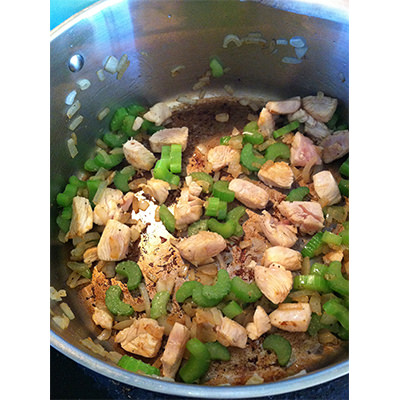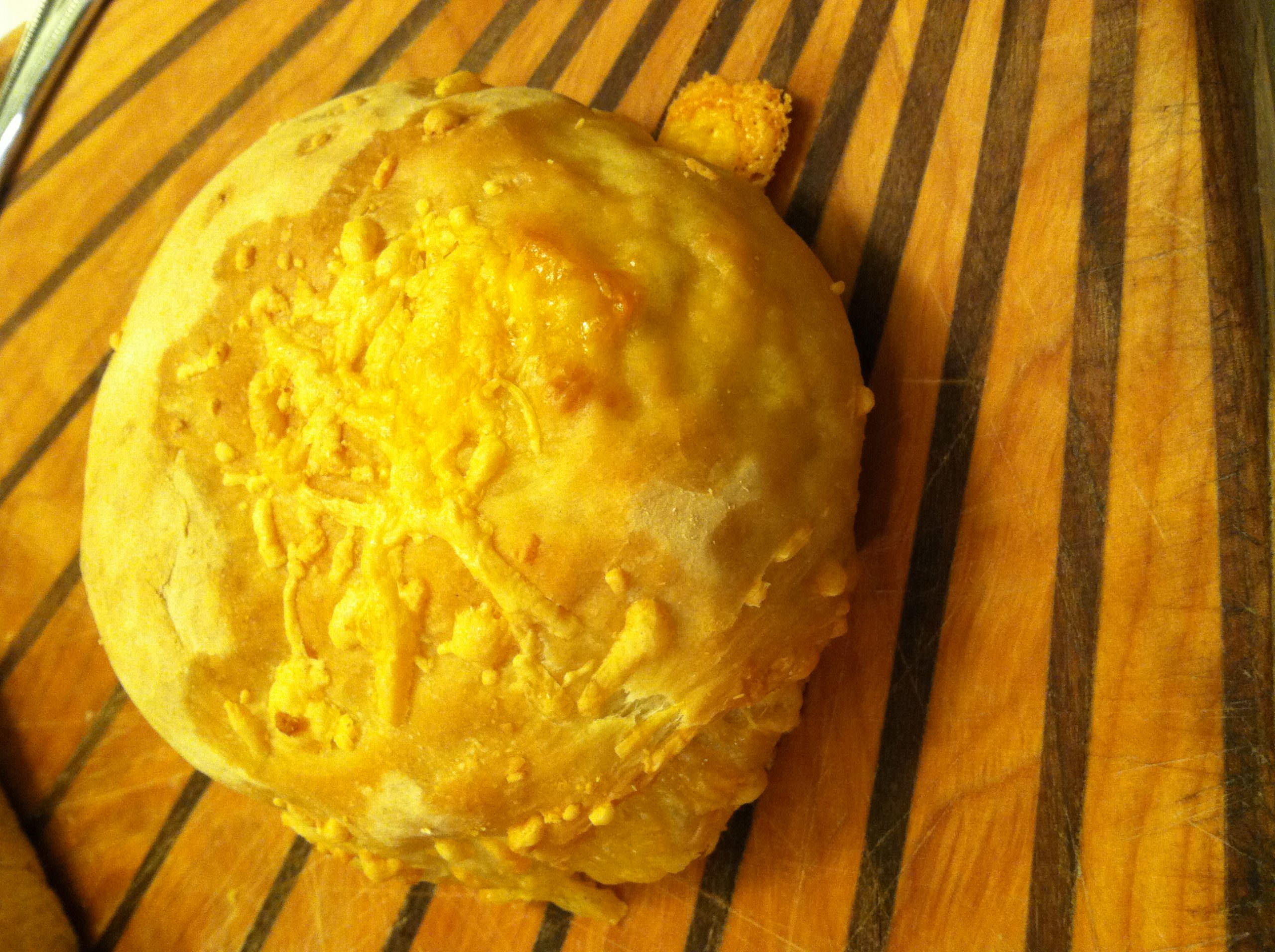Story and photos by Jennifer Rachel Baumer
A bowl of hot soup is just the ticket on a cold winter’s night when the rain and snow blow against the windows. Chicken noodle soup is the traditional panacea against winter plagues, from colds to flu. There’s something about the combination of salty richness and bites of chicken that’s both cheering and soothing. Pair the soup with a cheese-laced bread that’s prepared quickly (for yeast bread, anyway) and lasts well, and you’ve got yourself simple, hearty, warming feast.
Chicken (or Turkey) Noodle Soup
(courtesy of Jennifer Rachel Baumer. Serves 4)
About 1 to 2 cups chopped chicken or turkey, cooked or uncooked
1 tablespoon butter
2 to 4 stalks celery, chopped to about ½-inch pieces
½ medium yellow onion, chopped
6 cups water and 6 chicken bouillon cubes or equivalent OR 6 cups chicken or turkey stock
1 cup frozen corn kernels
Egg noodles or No Yolks egg noodles, extra broad —about 6 ounces
In a large, heavy saucepan or Dutch oven, melt the butter over medium high heat. Sauté onion and celery until tender, then remove if meat is uncooked; cook chicken completely before adding the vegetables back in. If you’re using poultry that’s already cooked, just heat it coated in the melted butter at the same time you sauté vegetables. (This is a great recipe if you make stock from turkey carcass and use the last bits of turkey meat for the soup. I may love the turkey noodle soup more than the chicken.)

Chicken & Vegetables brown in a sauté pan
While chicken and vegetables cook, either heat 6 cups of water to make chicken bouillon or measure out 6 cups of stock. Once the chicken and vegetables are ready, add stock and heat to nearly boiling. Add frozen corn and let soup come back up to nearly boiling. Add noodles and turn soup to simmer loosely covered until noodles are soft (or until you’re ready for it). This is a good time to add a twist of freshly ground black pepper and maybe lightly salt the soup.
Before serving, if you want a thicker soup, take out a cup that’s more chicken and vegetables than noodles and purée it a bit in the blender before stirring it back into pot.
This soup keeps well, freezes well, and tastes great cold the next day if you’re so inclined. Enjoy it with a slab of warm cheese bread!
Cheddar Cheese Bread
(courtesy of Jennifer Rachel Baumer. Makes 1 standard-sized loaf and 1 smaller freeform round loaf)
This bread takes between three and four hours, even when it’s 25 degrees outside. It rises well and bakes fast, and despite what purists insist about waiting until bread is stone cold to cut it, it’s best after it’s been out of the oven 20 to 30 minutes, still warm with the cheese still soft.

Cheddar cheese bread cools on a cutting board
1 envelope active dry yeast (not rapid rise), or 2¼ teaspoons, or 1 yeast-measuring spoon’s worth
1¾ cups very warm water (¼ cup + 1½ cups)
2½ teaspoons sea salt
4 to 5 cups unbleached flour
2 cups extra-sharp cheddar, grated (6 to 8 ounces)
Vegetable or canola oil to grease pans and bowl
Pour ¼ cup of the very warm water into large mixing bowl. Sprinkle yeast over it and let stand for 5 minutes.
Stir salt into yeast and water to dissolve yeast completely. Add rest of warm water. Add 3 to 3½ cups of the flour, and stir to create a sticky, cohesive dough. It’s rare in this dry climate to use all five cups of flour, and it’s better to start working dough when it’s on the sticky side and add flour sparingly. Too much flour makes a dull, flat, dry loaf.
As soon as dough is a rough mass that can be handled, lift onto a clean, dry, well-floured work surface and begin to knead. (This is a good time to soak the bowl if it’s the one bread will rise in). Knead anywhere from 5 to 10 minutes, adding reserved flour gradually and sparingly. The dough should just barely stick to your fingers and not be a tacky, sticky mess, but also not so dry that it’s breaking apart. If it starts to get too dry, stop adding flour, brush most of the flour off your work surface, and then knead for a minute or two — most of the time the dough will incorporate that flour and begin to stick to you again. Then re-flour your board sparingly and continue kneading.
When dough is stretchy and elastic and no longer soaking up extra flour, let it sit on the board while you clean out mixing bowl and lightly oil it. Gather dough into a ball, place it in bowl, and spin it so all sides are lightly coated with oil. This stops it from creating a dry, crusty skin while rising. Cover with light, clean dish towel, piece of cling wrap, or sheet of wax paper. Leave dough to rise in an undisturbed, draft-free area. Leaving it on top of the oven, if the oven is in use, or in a spill of sunlight will encourage it to rise more quickly. This bread doesn’t need a long, slow rise, and in summer or in a warm spot the first rise can take as little as 45 minutes in high altitudes. On a cold, snowy night, it might take 1 to 1.5 hours.
When dough has risen to double, lightly flour your fingers and gently press dough back down, replace cover, and let it rise a second time.
After second rise, turn dough out on a floured surface and knead in your grated cheddar cheese. I like a coarse grating, so the pieces are wide and more than 1 inch long. I’m probably using about 8 ounces of cheese, or 2 cups or so. It’s not an exact measurement, and not all of the cheese gets kneaded in every time.
Try not to overly deflate dough before starting to knead in cheese. Flatten dough into a rough circle or disc, sprinkle on cheese, and start gently kneading until it’s incorporated. It’s better to have all cheese within dough, not showing on the surface, or that cheese will burn or simply leak out and away during baking.
Separate dough into 2 unequal parts. Two-thirds of the dough is used to shape a kind of oblong football shape and tuck that into the greased loaf pan. The smaller piece is formed into a small, round loaf and does nicely in a greased glass pie pan. Cover with a clean tea towel and allow to rise for another 45 to 60 minutes while the oven preheats to 450 degrees F.
Bake both loaves for 20 minutes, then remove smaller loaf, reduce oven temperature to 350 degrees F, and bake another 5 to 10 minutes. Keep an eye on it — it can quickly overcook. If either bread becomes too dark during baking, just gently drape a piece of foil over it and let it finish baking. Remove breads from pan and flick or tap bottoms — they should sound hollow. Give bread about 20 to 30 minutes to cool or it will squish when cut and taste cloyingly wet.

